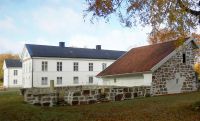You are here:
Abbeys > Sweden > Götaland > Herrevad
Herrevad

Herrevad Abbey was founded from Cîteaux Abbey in 1144 as Denmark's first Cistercian monastery with the support of Archbishop Eskil of Lund. Eskil wrote to Bernard of Clairvaux requesting twelve Cistercian monks from Cîteaux Abbey under the leadership of Robert, the first abbot of Herrevad, to come to Denmark to establish a new monastery. Later an additional nine lay brothers were also despatched to instruct the Danes in the crafts and agricultural practices associated with the Cistercian Order. Archbishop Eskil gave the land for the site of the abbey and paid for its construction.
The abbey was consecrated in 1150. Over time it became one of the largest and wealthiest monastic houses in Denmark, and certainly in Skåne, then part of Denmark until 1658. At its height, the abbey owned more than 400 income-producing properties. It enjoyed the support of the nobility and Denmark's royal family for generations. Herrevad established three daughter houses in Denmark - Holme Abbey, Tvis Abbey and Løgum Abbey.
In 1536 during the Protestant Reformation Denmark became a Lutheran kingdom, and all religious houses and their property fell to the crown. Herrevad was given to Sten Bille, a prominent nobleman, the uncle of Tycho Brahe. Tycho Brahe became a world-famous astronomer at Herrevad when on the night of 11 November 1572 he recorded a new star "brighter than Venus" located in the constellation Cassiopeia. He published his findings at Copenhagen in 1573 and these became the basis for his fame as an astronomer.
Skåne was united with Sweden 1658 and Herrevad was put at the disposal of the Swedish state. Over time the abbey fell into ruin. Two remaining structures survived to this day. One of them is used as a church today, the other one is part of the Herrevad Castle.
[ Back ]
